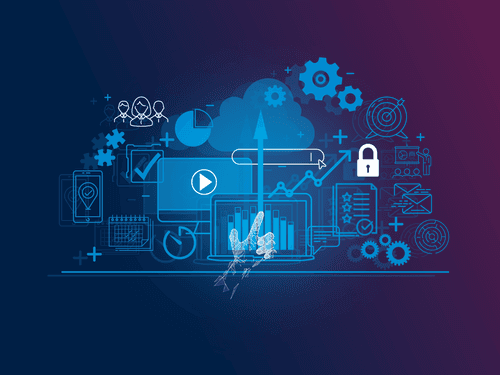You have probably started hearing the buzz about Web3, also known as Web 3.0. According to Google Trends, the increase in searches for “Web3” over the past few years show the increased interest and growing conversations online.
The growth in purchases of digital goods (example: NFTs on OpenSea) have outpaced physical goods in both volume and frequency in the past year. Mark Zuckerberg made his investment into Web3 by changing the name of Facebook to Meta and Starbucks revealed a Web3 rewards program for its loyal, tech-savvy customers. Everyone is talking about this, but what the heck is it?
In this article, we will provide a brief history of the inter-webs, the main ideas behind this new iteration, and outline what the implications will be for you and your brand. Come along with us on this journey into the future …
Web 1.0: The Birth of the Internet, 1991-2004

In the early days of the internet, the first generation, or “Web 1.0” was focused on providing static information to users. Websites were essentially online brochures, with limited interaction or two-way communication between the user and the website.
Free webhosting services (remember Angelfire or GeoCities?) led to the creation of innumerable personal pages. America Online (AOL) was how we met and stayed connected with online friends (pre-Facebook), and AskJeeves was where you would make search inquiries (pre-Google).
It was difficult to track user activity and website traffic because, well, it was such a mess! But this is where email marketing got started, along with search engine optimization and some paid advertising, laying the foundation for what was to come.
Web 2.0: The Participative Social Web, 2004-Present

As the internet evolved, the second generation, or “Web 2.0” emerged. This version of the web is characterized by the ability of users to interact with websites and with one another in a more dynamic way. This was made possible through the development of technologies like mobile browsing, social media, and cloud technology.
Mobile internet browsing and user tracking helped digital marketing explode! Businesses were able to monitor how consumers interacted with their websites thanks to analytics and tracking, which significantly impacted how prospective clients are targeted.
The present era is marked not only by targeted advertising but also by a lack of user privacy, with major platforms offering free usage in exchange for users’ data. This has made email marketing, organic content, paid ads, and SEO more accurate while emphasizing the importance of user data and personalization.
In short, Web 2.0 has connected the world but leaves its users exposed.
Web 3.0: The Decentralized Web, 2017-The Near Future

Today, we see the emergence of “Web 3.0,” which focuses on the development of decentralized and distributed technologies like blockchain and peer-to-peer networks. These systems enable users to interact directly with each other rather than through a central authority (such as Facebook or Google). This third generation of the internet has the potential to revolutionize the way businesses approach marketing and reach their target audiences.
With Web 3.0, users have more control over their data and can choose which information they share with applications. This creates a more personalized and user-centric experience. Web 3.0 also promises to be even more interactive and personalized, with the ability for websites to understand and anticipate the needs and preferences of individual users.
One key difference between these iterations of the internet is the level of interactivity and user control. Web 1.0 was a one-way flow of information, while Web 2.0 promoted interaction and user-generated content (owned by centralized authorities who exert control and influence, sometimes against the interests of its users). Web 3.0 takes this a step further by releasing user-generated content without central authorities exerting control or monetizing personal data.
Some other key differences between these three generations of the web include:
- Web 1.0: Static websites, limited interactivity, used for information sharing
- Web 2.0: Interactive and user-centric, allows for user-generated content and collaboration, introduced social networking and other social media tools
- Web 3.0: Enables a peer-to-peer web without central servers or authorities to monetize personal data or manage the flow of information
It’s important to understand these different generations of the web and how they have evolved into the version of the internet we know today. Consumers expect a more interactive and personalized experience, and Web 3.0 can help your brand create more effective campaigns, resulting in a greater ROI and more satisfied customers. By understanding the capabilities of Web 3.0, you can create the integrated marketing strategy to reach and resonate with your target audience.
The Details of Web 3.0:
One of the main benefits of marketing in Web 3.0 is the ability to build and deploy decentralized applications (or “DApps”). DApps are applications that run on a decentralized network (blockchain) and aren’t controlled by any single centralized entity. This supports greater transparency and trust between businesses and their customers by cutting out the middleman. DApps can provide a more transparent way for your brand to track and analyze customer engagement and behavior, which can help inform and improve your marketing strategies.
Another potential advantage of Web 3.0 is the ability to leverage non-fungible tokens (NFTs) in marketing campaigns. NFTs are unique digital assets, verified on the blockchain, representing ownership of a physical or digital item. Businesses can use NFTs to create exclusive and limited-edition products or offer them as rewards for customer loyalty or participation in marketing campaigns. Starbucks unveiled its blockchain-based Starbucks Odyssey experience for its Rewards Members, where users can earn one-of-a-kind digital collectibles for engaging in various activities on the platform. This project builds upon its existing community by using blockchain technology to enhance the business and expand its loyalty program.
In addition to DApps and NFTs, Web 3.0 also offers the potential for targeted and personalized marketing using smart contracts. Smart contracts are self-executing contracts with the terms of the agreement between buyer and seller being directly embedded into lines of code. This allows for the creation of personalized marketing campaigns that can be triggered based on specific actions taken by the individual customer.
There are several potential benefits that your brand could derive from Web 3.0 technologies, including:
- Improved efficiency: Web 3.0 technologies could help to streamline the way your business processes and manages data, facilitating the ability to gain insights and make informed marketing decisions based on real-time data.
- Enhanced customer experience: Web 3.0 technologies could enable your brand to offer more personalized and relevant experiences to your customers, making it easier to understand and interpret their preferences and behaviors.
- Enhanced security: Web 3.0 technologies could help to improve the security of your brand’s online presence, offering superior verification data authenticity and protection against cyber threats.

Image Credit: Blockchain Council
Web 3.0 technologies could help your brand to be more efficient, effective, and successful in tomorrow’s digital landscape. While the technology is still in its early stages, the possibilities for using Web3 in marketing campaigns are endless, and it will be exciting to see how businesses leverage this technology in the future.
The Marketing Implications of Web 3.0:
In terms of marketing, Web 3.0 technologies present a few opportunities and challenges.
On one hand, they provide a new platform for building and promoting your brand, as well as new ways to interact with and engage with your customers. For example, you could use blockchain technology to create a decentralized marketplace for your products or use peer-to-peer networks to communicate directly with your customers.
On the other hand, the decentralized nature of Web 3.0 means you will need to adapt your marketing strategies to this new environment. You may need to find new ways to reach and engage with your customers, as well as new ways to measure and track the effectiveness of your marketing efforts. Additionally, you will have to be mindful of the regulatory and legal considerations associated with decentralized technologies, and the potential for competition from other brands also adopting these technologies.
The marketing implications of Web 3.0 technologies are still evolving, and it will be important for brands to stay up to date with developments to be competitive and take advantage of these new opportunities.
Are You Ready for Web 3.0?
Brands can benefit from Web 3.0 by tapping into new business opportunities made possible by decentralized technology and creating a more authentic and personalized customer experience. These disruptive, revolutionary ideas will forever change how brands do business on the internet.
As Web 3.0 continues to grow, so will Element’s expertise on this exciting new evolution. Contact us to continue the discussion about Web3 and how your business can navigate this new digital ecosystem.









